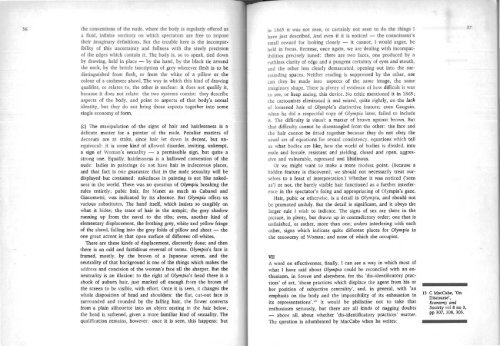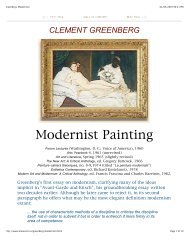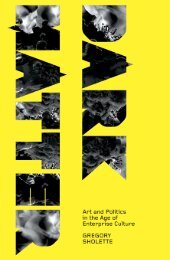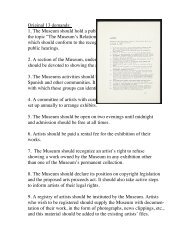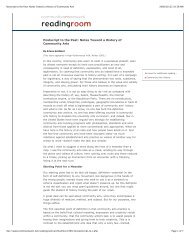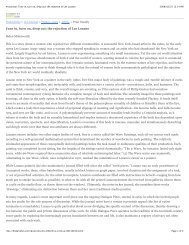Screen - Dark Matter Archives
Screen - Dark Matter Archives
Screen - Dark Matter Archives
Create successful ePaper yourself
Turn your PDF publications into a flip-book with our unique Google optimized e-Paper software.
36 the conventions of the nude. wbere the body is regularly offered asin 1865 it was not seen, or certainly not seen to do the things I37a flujd, infinite territory on which spectators are free to imposehave just described. And even if it is noticed - the connoisseur'stheir imaginary definitions. But the trouble here is the incompatibilityof this uncertainty and fu llness with the steely precisionof the edges which contain it. The body is. so to speak. tied downsmall reward for looking closely - it cannot. I would argue. beby drawing. held in place - by the hand. by the black tie aroundthe neck. by the brittle inscription of grey wherever flesh is to bedistinguished from flesh, or from the white of a piUow or thecolour of a cashmere shawl. The way in which this kind of drawingqualifies. or relates to. the other is unclear: it does not qualify it.because it does not relate : the two systems coexist: they describeaspects of the body. and point to aspects of that body's sexualidentity. but they do not bring those aspects together into somesingle economy of form.(c) The manipulation of· the signs of hair and hairlessness is adelicate matter for a painter of the nude. Peculiar matters ofdecorum are at stake, since hair let down is decent, but unequivocal:it is some kind of allowed disorder, inviting, unkempt,a sign of Woman's sexuality - a permissible sign, but qujte astrong one. Equally, hairlessness is a hallowed convention of thenude: ladies in paintings do not have hair in indecorous places,and that fact is one guarantee chat in the nude sexuality wiU bedisplayed but contained: nakedness in painting is nOt Jike nakednessin the world. There was no question of Olympia breaking therules entirely: pubic hair. for Manet as much as Cabanel andGiacomotti. was indicated by its abse nce. But Olympia offers usvarious substitutes. The hand itself. which insists so tangibly onwhat it hides; the trace of hair in the armpit; the grey shadowrunning up from the navel to the ribs: even, another kind ofelementary displacement. the frotbing grey. white and yellow fringeof the shawl. falling into the grey folds of pillow and sbeet - theone great accent in that open surface of different off· whites.There are these kinds of displacement. discreetly done; and thenthere is an odd and fastidious reversal of terms. Olympia's face isframed. mostly. by the brown of a Japanese screen. and theneutrality of that background is one of the things which makes tbeaddress and concision of the woman's face aU the sharper. But theneutrality is an illusion: to the right of Olympia's head there is ashock of auburn hair. just marked off enougb fr om the brown ofthe screen to be visible. with effort. Once it is seen, it changes thewhole disposition of head and shoulders: the flat. cut-out face issurrounded and rounded by the falling hair. the flower convertSfcom a plain silhouette into an object resting in the hair below ;the head is softened. given a more familiar kind of sexuality. Thequalification remains, however: once it is seen, this happens: butheld in focus. Because, once again, we are dealing with incompatibilitiespreCisely tuned: there are two faces, one produced by aruthless clarity of edge and a pungent cenainty of eyes and mouth.and the other less clearly demarcated. opening out into the surroundingspaces. Neither reading is suppressed by tbe other, norcan they be made into aspects of the same image, the sameimaginary shape. There is plenty of evidence of how difficult it wasto see , or keep seeing. this device. No critic mentioned it in 1865;the cartoonists eliminated it and seized, quite rightly, on the lackof loosened hair of Olympia's distinctive feature; even Gauguin,when he did a respectful copy of Olympia later. failed to includeit. The difficulty is vis ual: a matter of brown against brown. Butthat difficulty cannot be disentangled from th e other: the face andthe hair cannot be fitte d together because they do not obey theusual set of equations for sexual consistency, equations which tellus what bodies are like, how tbe world of bod ies is divided, intomale and fema le . resistant and yielding. closed and open, aggressiveand vulnerable, repressed and libidinous.Or we might want to make a more modest point. (Because ahidden feature is discovered, we sbould not necessarily treat ourselvesto a fea st of interpreta tion.) Whether it was noticed ('seenas') or not, the barely visible hair funC[ioned as a furth er interfer·ence in the spectator's fixing and appropriating of Olympia's gaze.Hair, pubic or otherwise, is a detail in Olympia, and should notbe promoted un duly. But the detail is significant. and it obe)'s thelarger rule I wish to indicate. The signs of sex are tbere in thepicture, in plenty, but drawn up in contradictory order ; one that isunfinished, or rather, more than one; orders interfering \\i th eachother. signs which indicate quite different places for Olympia inthe taxonomy of Woman ; and none of which she occupies.VIIA word on effectivt!ness, finally . t can see a way in which most ofwhat [ have said about Olympia could be reconciled with an enthusiasm,in <strong>Screen</strong> and else.where, for the 'dis-identificatory practices'of art, 'those practices wbich displace the agent from his orher position of subjective cenrrality', and , in general, with 'anemphasis on the body and the impossibility of its exhaustion inits representations'Y It \vould be phiHsrine not to take thatenthusiasm seriously, but there are aU kinds of nagging doubts- abo\'e all, about whether 'dis-identificatory practices' matter.The question is adumbrated by MacCabe when he writes:13 C MacCabe. 'OnDiscourse',Economy andSociety vol 8 no 3.pp 307. 308. 303.


